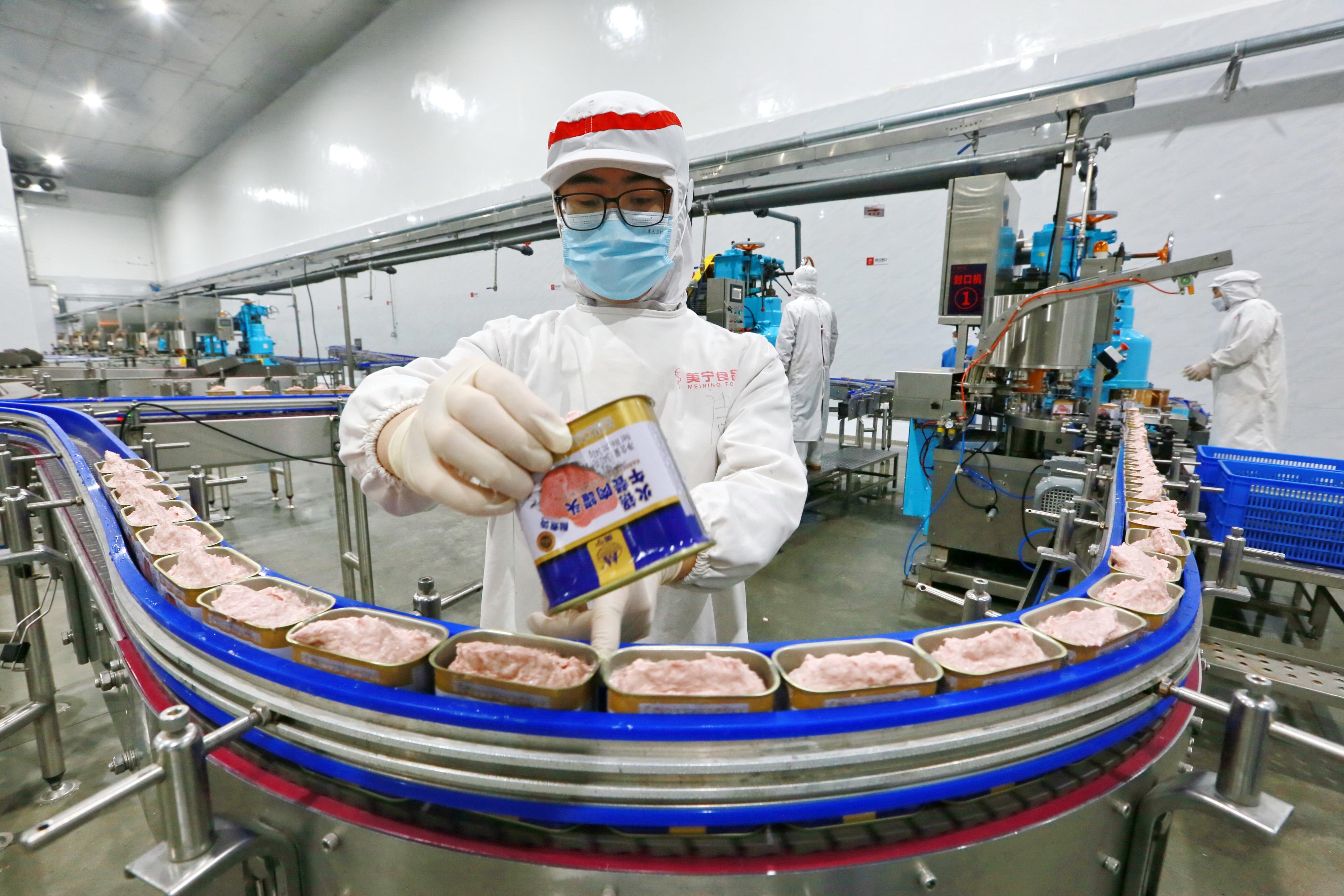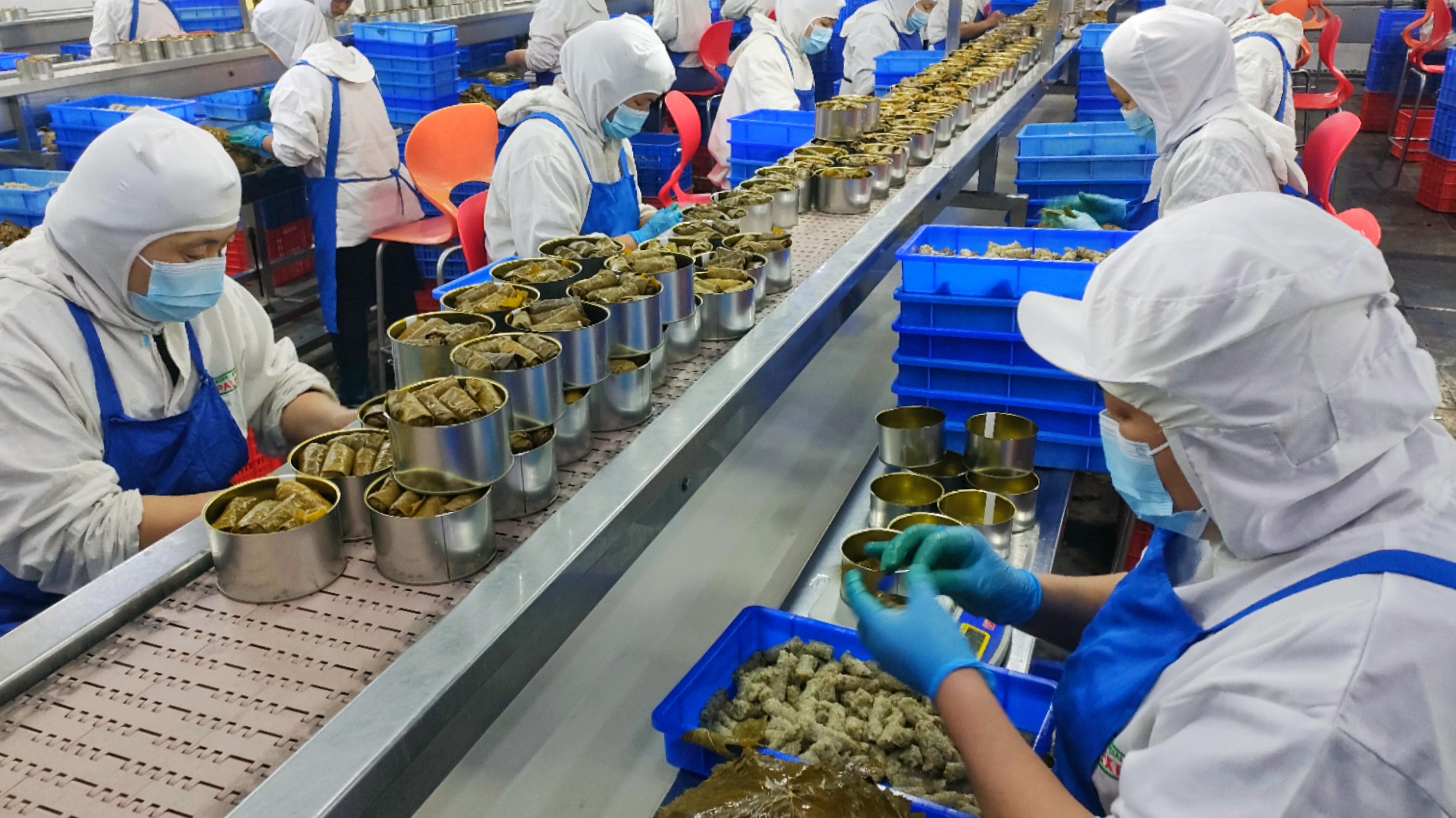Production capacity expanded to cater to wide range of tastes
 Canned oranges are produced at a factory in Zigui, Hubei province. (PHOTO / XINHUA)
Canned oranges are produced at a factory in Zigui, Hubei province. (PHOTO / XINHUA)
Cans containing Dolma — salty rice and meat wrapped in pickled grape leaves — were loaded onto trucks at a company in Heze, Shandong province, this month, before being transported to Qingdao Port for shipment to Europe, where demand for the product is growing.
Despite not meeting the taste preferences of most domestic consumers, China has exported a large volume of this food to many countries in Europe and the Middle East.
We have seen booming sales and growing overseas orders for our canned apples and pears in syrup.We are continuing to develop new products, markets and customers, and have expanded our overseas market share.
Guo Yiji, trade manager of Yantai Shenglong Food Co in Yantai, Shandong province, which exported 629 metric tons of canned fruit in the first quarter of this year
This year, canned food exports from China have continued to rise as inflation remains high in some countries, with prices of food sourced locally soaring.
Dolma is the main product of Heze Palexpo Food Co, which is based in the city of Heze.
This year, the company has received a growing number of overseas orders. Its sales revenue reached 6.5 million yuan ($935,000) in January, 7 million yuan in February and 8 million yuan in March.
Most of its products were exported to Saudi Arabia, the United Arab Emirates, Kuwait, Germany and the United States. Recently, the company received more orders from other markets such as northern Europe.
Antonios Vassatis, the company's general manager, who is Greek, said: "In the past few years, COVID-19 has had a negative impact on demand for Dolma internationally, and our orders have fluctuated. Europe has become a new market, which has given us fresh business opportunities.
"Many Chinese consumers are not used to the taste of grape leaves, but Greeks have been enjoying them for hundreds of years. They are a typical pre-meal snack for residents in the Middle East, where they are regarded as a staple food in some countries. The rice our company uses is non-genetically modified, and we have our own professional cooperatives and planting areas."
Last year, China exported 3.13 million metric tons of canned food, a 12 percent rise year-on-year. The value of such exports in the nation reached $6.89 billion, up by 22 percent on the figure for 2021, with both the export volume and value hitting record highs in recent years, the China Canned Food Industry Association said.
The association added that last year, canned food exports to the United States rose by 19 percent year-on-year, to Russia by 23 percent, and to Hong Kong by 63 percent.
Vassatis said that to better satisfy preferences in different countries and regions, the company has broadened the range of flavors it offers. In addition to Dolma, which tastes of tomatoes, lemons and pomegranates, it introduced flavors such as pepper and parsley.
 Workers make canned meat at a factory in Suining, Sichuan province. (ZHONG MIN / FOR CHINA DAILY)
Workers make canned meat at a factory in Suining, Sichuan province. (ZHONG MIN / FOR CHINA DAILY)
The company also improved the design of its packaging — introducing a new wrapper that makes it easier to recognize the brand, and which has helped the company boost its reputation abroad and increase its market share.
In 2011, the head of Heze Palexpo found there were abundant grape leaves in the western part of China, and had the idea of building a factory to manufacture Dolma. Vassatis then traveled to the country to choose a site and set up the new business.
The company has received orders from the United Kingdom, Sweden, Greece and other European countries. Its annual export value exceeds $11 million, while the number of its employees has grown to more than 400.
Heze Palexpo has also obtained certification to produce vegetarian, halal and kosher food. A comprehensive quality control system has enabled the company to gain strong market competitiveness in global trade.
With growing demand for canned food overseas, enterprises in China have expanded their production capacity, and the export categories and total export volumes for such food are expected to continue rising.
Early last month, 18 tons of canned apples were shipped to Japan from Yantai, Shandong. The cans were produced by Yantai Shenglong Food Co. In the first quarter, the company exported 629 tons of canned fruit, more than double the volume compared with the same period last year.
Guo Yijia, the company's trade manager, said: "This year, we have seen booming sales and growing overseas orders for our canned apples and pears in syrup. Canned food is convenient to eat, has a long quality guarantee period, and is relatively cheap. We are continuing to develop new products, markets and customers, and have expanded our overseas market share."
 Dolma, a type of canned food, is produced at Heze Palexpo Food Co in Heze, Shandong province. (PHOTO PROVIDED TO CHINA DAILY)
Dolma, a type of canned food, is produced at Heze Palexpo Food Co in Heze, Shandong province. (PHOTO PROVIDED TO CHINA DAILY)
Most Chinese consumers consider the shelf life of canned food to be relatively long, but that such food contains a large amount of preservatives, which could be harmful to health. As a result, they feel that eating fresh food is a healthier option.
Unlike the Chinese market, canned food is a typical choice for many consumers in Europe and the US.
Although there is low enthusiasm for such food among consumers in China, the domestic canned food industry has established a solid foundation and has developed rapidly.
In the 1950s, China exported canned food for the first time, starting with a small volume of fruit. Later, the export varieties and quantity increased gradually each year.
In recent years, more than half the top 10 countries with the highest consumption volumes for canned food globally were in Europe, with Sweden topping the list. The annual per capita consumption volume for canned food in Sweden exceeds 33 kilograms, about six times higher than that in China, data from the China Canned Food Industry Association show.
Asia, Europe, Africa and North America are China's largest export destinations for canned food. Tinned vegetables and fruit account for the largest share, and export volumes of canned instant food and mushrooms have risen significantly in recent years, the General Administration of Customs said.
Sun Baiyu, manager at a food trading company based in Shenzhen, Guangdong province, said inquiries about shipping canned food overseas are placed on social media platforms every day. He visits local customs officials frequently to complete clearance procedures for exporting canned corn and bamboo shoots.
With overseas demand mounting for canned food from China, the company exported 500 containers last year. After a sharp rise in orders in the first quarter of this year, it expects the export volume for its products to rise by 20 percent this year compared with 2022.
 A customer inspects a jar of peaches at a supermarket in Jilin, Jilin province. (PHOTO / CHINA NEWS SERVICE)
A customer inspects a jar of peaches at a supermarket in Jilin, Jilin province. (PHOTO / CHINA NEWS SERVICE)
Other canned food manufacturers in Guangdong have also boosted their production capacity since the second half of last year to meet increased overseas demand.
Li Zhongbin, general manager of Jiangmen Jiangfan Aquatic Products Co, said the company has expanded production capacity, as demand for canned vegetables, seafood and mushrooms has risen significantly since July.
Based in Jiangmen, Guangdong, the company started producing canned vegetables in 2004. This year, the volume of its monthly orders rose by about 10 percent year-on-year.
Canned food is produced by more than 46,000 enterprises in China, with Guangdong topping the list with over 14,000 such companies. Qichacha, a company that tracks business registrations, said that last year, 430 companies registered to produce canned food in China.
In the domestic market, evolving lifestyle and consumption patterns have resulted in the canned food industry embracing a long-awaited business opportunity, fueled by the popularity of ready-to-cook meals, especially since the pandemic emerged.
Semi-cooked and quick-frozen Chinese food only requires simple reheating, and can be delivered with extended quality guarantee times. Sales of such meals, including meat, seafood, vegetables and hot pot, have grown rapidly.
Producing precooked dishes such as braised pork ribs and high-end ingredients like abalone requires vital sterilization and sealing processes, and related technologies in the canning process.
Industry experts forecast that the continued emergence of new concepts, formats and models in food production and distribution, coupled with changes in consumer demand, will provide new business opportunities for the revitalization of the canned food industry in China.
Contact the writers at zhuwenqian@chinadaily.com.cn


